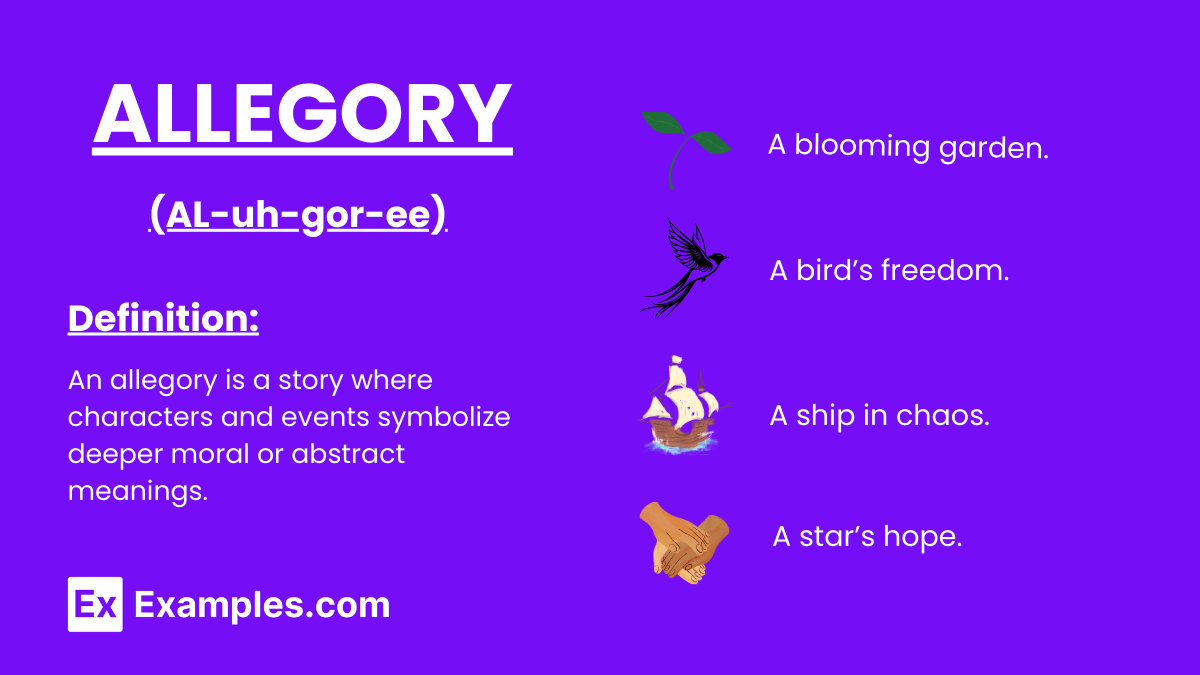Allegory
What is Allegory? – Definition
Allegory is a literary device where characters, events, or settings symbolize broader concepts, ideas, or moral lessons, often conveying a deeper meaning beyond the literal narrative.

Generated Allegory Examples

Download Allegory Examples
Enhance your understanding with our comprehensive PDF guide.
Download PDFExamples of Allegory
- The river’s flow represents the unstoppable passage of time.
- The broken bridge symbolizes lost connections or relationships.
- A phoenix rising from ashes represents rebirth and resilience.
- The blooming flower symbolizes newfound hope and opportunity.
- The maze represents the complexity of life’s decisions.
- The flight of birds symbolizes the freedom of the soul.
- The marathon represents life’s struggles and perseverance.
- A barren tree symbolizes the loss of hope and vitality.
- The storm represents turmoil and uncontrollable emotions.
- The dawn signifies the beginning of a new chapter in life.
- I will not give up, I will not surrender, I will not lose hope.
- For the trees, for the animals, for the planet, we must act now.
- Under the sun, under the sky, under the stars, I will find you.
- As time passes, as moments fade, as memories linger, we move forward.
- In the spring, in the summer, in the autumn, we shall meet again.
- Through the storm, through the rain, through the darkness, I will find the way.
- I will run, I will leap, I will soar above the challenges.
- For my family, for my friends, for my home, I will work tirelessly.
- For peace, for love, for unity, we must come together.
- I see hope, I see change, I see progress in every step.
- Every hour, every second, every heartbeat, I am here for you.
- The circle of life, the circle of love, the circle of hope will go on.
- We laugh together, we cry together, we grow together.
- Sing with joy, sing with hope, sing with all your heart.
- Run to your dreams, run to your goals, run to your destiny.
- Now is the time, now is the moment, now is our chance.
- For my nation, for my people, for our future, I will persevere.
- Fly to new heights, fly to new dreams, fly to a better tomorrow.
- Through the storm, through the night, through the fire, I will keep going.
- Rise with strength, rise with courage, rise with hope.
Types of Allegories
Moral Allegories
These allegories convey ethical or moral lessons through symbolic characters or situations.
- A wise owl symbolizes the value of knowledge over ignorance.
- A fork in the road represents moral choices between right and wrong.
- A bright light shining through darkness symbolizes truth overcoming lies.
- A rose among thorns represents virtue amidst vice.
- A scale tipping unevenly represents justice corrupted by greed.
Political Allegories
These allegories reflect political ideologies, events, or societal issues.
- A divided kingdom represents a fractured society or political unrest.
- A collapsing tower symbolizes the downfall of corrupt regimes.
- A group of animals working together symbolizes unity in diversity.
- A broken chain represents liberation from oppression.
- A courtroom drama symbolizes the fight for justice.
Religious Allegories
These allegories use symbolism to explore spiritual or theological concepts.
- A garden symbolizes paradise or spiritual renewal.
- A guiding star represents divine guidance or enlightenment.
- An anchor symbolizes hope and steadfast faith.
- A long and winding road represents the journey of faith.
- A rising sun represents resurrection or renewal.
Philosophical Allegories
Allegories that explore deep existential and philosophical ideas.
- A cave symbolizes ignorance and the journey to enlightenment.
- A tree with many branches represents interconnectedness in life.
- An hourglass symbolizes the fleeting nature of time.
- A spinning wheel represents the cycles of life and rebirth.
- A mirror reflects the quest for self-awareness and identity.
Historical Allegories
These allegories are based on historical events and convey lessons from the past.
- A battlefield represents sacrifice and courage during wartime.
- A rising flag symbolizes victory and pride.
- A crumbling castle represents the fall of great empires.
- A lit torch signifies progress and enlightenment.
- A united crowd represents the strength of collective action.
Environmental Allegories
Allegories that focus on nature, conservation, and human impact on the environment.
- A dying tree symbolizes the destruction of ecosystems.
- A dry riverbed represents the consequences of climate change.
- A flourishing forest represents the harmony of nature.
- A storm symbolizes humanity’s exploitation of nature.
- A mountain range represents the resilience and beauty of the natural world.
How to Identify an Allegory?
To identify an allegory, look for a narrative, character, or setting that symbolizes abstract ideas or concepts. Allegories often have a deeper meaning beyond their literal interpretation, reflecting themes like morality, politics, or religion.
- Examine the story or artwork for symbols or metaphors representing abstract ideas.
- Identify recurring themes or patterns that suggest a deeper meaning.
- Look for characters or events that represent larger concepts, like good vs. evil.
- Analyze how the narrative reflects real-world moral, political, or spiritual issues.
- Contrast the literal story with its symbolic or allegorical interpretation.
How to Develop an Allegory?
Developing an allegory involves crafting a story, characters, or setting that symbolizes a larger message or idea. Use allegory to convey complex themes or universal truths through symbolism.
- Choose a theme or message you want to convey, like morality or justice.
- Create symbolic characters, objects, or events that represent abstract ideas.
- Weave the allegory naturally into the story to avoid making it too obvious or forced.
- Use imagery and metaphors to deepen the symbolic meaning of your narrative.
- Refine your story to ensure the allegory is clear but still allows for interpretation.
Other Allegory Examples
Allegories in Society
These allegories depict social structures, norms, and challenges, often critiquing or reflecting societal realities.
- A crowded marketplace represents the diversity of human interaction.
- A broken bridge signifies a fractured society.
- A thriving village represents communal harmony and cooperation.
- A dimly lit room symbolizes ignorance and fear of change.
- A united choir reflects the power of collective voices in society.
Moral Allegories
These allegories convey lessons about right and wrong, guiding readers or viewers toward ethical reflection.
- A golden tree represents the reward of honesty and virtue.
- Two roads splitting in a forest symbolize the choices of good and evil.
- A blooming flower represents the growth of kindness and empathy.
- A knight’s shield signifies the strength of integrity.
- A balanced scale reflects the importance of fairness.
Historical Allegories
Allegories inspired by historical events or figures, offering insights or critiques of the past.
- A crumbling tower represents the fall of an empire.
- A battlefield of roses signifies the cost of revolution.
- An hourglass with broken sand symbolizes a lost era.
- A book with torn pages represents suppressed history.
- A group of stars represents unity among diverse nations.
Environmental Allegories
Allegories that highlight environmental issues, sustainability, and the relationship between humans and nature.
- A dying forest represents humanity’s neglect of the environment.
- A polluted river symbolizes the consequences of human greed.
- A flourishing garden represents hope and renewal in nature.
- A tree shedding leaves signifies the cycle of life and rebirth.
- A lone wolf symbolizes nature’s struggle against extinction.
Philosophical Allegories
Allegories that delve into questions of existence, morality, and the human condition.
- A winding path represents the journey of self-discovery.
- A shattered mirror symbolizes fragmented identity.
- An endless horizon represents limitless possibilities.
- A flame that never dies signifies eternal hope.
- A flowing river represents the passage of time and life’s continuity.
Political Allegories
Allegories that critique or explore political systems, leadership, and ideologies.
- A puppet on strings represents a controlled or corrupt leader.
- A rising storm symbolizes the chaos of revolution.
- A cracked crown represents the fallibility of power.
- A phoenix rising from ashes symbolizes a nation’s recovery.
- A chessboard symbolizes the strategies and manipulations of politics.
Explore Other Literary Devices
Elevate Your AP English Preparation
Unlock your potential with our comprehensive AP English exam preparation tools designed to help you excel.
- Extensive Question Bank: Access 900+ exam-like questions for both AP English Language and Literature.
- Expertly Crafted: Questions mirror the structure and difficulty of actual AP exams, ensuring relevant practice.
- Detailed Explanations: Understand your mistakes with clear, concise breakdowns of correct and incorrect answers.
- Personalized Learning: Tailor your study sessions with topic-specific tests and adaptive learning tools.
- Comprehensive Coverage: Master all aspects of the AP English curriculum with extensive guides and resources.
Frequently Asked Questions
-
What is an allegory?
An allegory is a narrative that uses characters, events, or settings to symbolize abstract ideas or moral concepts, often conveying a deeper meaning. -
Why are allegories important in literature?
Allegories help convey complex ideas and moral lessons in a relatable and symbolic way, making them an effective tool for storytelling and education. -
Can allegories be found in modern media?
Yes, modern media frequently uses allegories in films, books, and television series to explore political, social, and moral themes. Examples include *The Matrix* and *The Hunger Games*. -
How can I identify an allegory?
To identify an allegory, look for consistent symbolism throughout the narrative, where characters and events represent deeper moral, political, or philosophical meanings. -
What are some classic examples of allegories?
Classic examples include George Orwell’s *Animal Farm* (symbolizing political systems), John Bunyan’s *Pilgrim’s Progress* (spiritual journey), and Plato’s *Allegory of the Cave* (philosophical enlightenment). -
How do I write an allegory?
To write an allegory, decide on the central theme or message you want to convey. Use symbolic characters, events, and settings to represent abstract ideas, weaving them into a cohesive and meaningful narrative.

